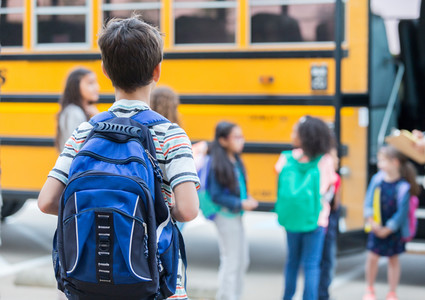




Family Health
How to Handle Bullying, Whether Your Child Is the Victim or the Aggressor
Published: Oct. 25, 2019

Life can be hard for children. As they try to understand their place in the world, they’re having new thoughts and emotions each day, their bodies are changing and growing, and they’re figuring out social dynamics and skills on the fly. An unfortunate addition to those challenges is the ever-present risk of bullying.
With October being National Bullying Prevention Month, it’s a great time to offer some tips and advice for parents and families on how to manage bullying in a child’s life.
What is bullying?
Bullying can take many forms. While we may imagine the stereotypical picture of a brute picking on a meek child, that’s not always the case.
At its core, and as stated by the American Academy of Pediatrics, bullying is unwanted, aggressive behavior that involves a real or perceived power imbalance. Sometimes the behavior happens once, but often it’s repeated. It can happen at school, in the neighborhood or online (via text or social media), and it may take the form of:
- Threats
- Rumors
- Verbal or physical attacks
- Intentional marginalization or exclusion
Consequences of bullying
Children who are bullied often experience serious physical effects, not only from the harm of physical abuse but also from the stress and anxiety of being bullied. The effects can include:
- Poor sleep
- Change in appetite
- Decreased concentration
- Headaches
- Stomachaches
It’s also estimated that more than 160,000 children miss school daily for fear of being bullied, affecting their ability to learn.
 Who’s a target and who’s the bully?
Who’s a target and who’s the bully?
Boys and girls can be victims and bullies. Sometimes a child is a victim and a bully. Typically, children who are bullied are seen as different from their peers. Their traits may include:
- Interests that are unusual or different from the norm
- Unusual appearance, such as “unpopular” or worn clothing, or being overweight or underweight
- Being new in school or perceived as less popular or having fewer friends
- Being out of touch with fads and trends
Perpetrators aren’t necessarily bigger, stronger or more popular than those they are bullying. Risk factors for being a bully include:
- Being well-connected to peers and having social power. These children are often overly concerned about remaining popular and will try to dominate or be in charge of others
- Being depressed, anxious or isolated from peers
- Being a victim of bullying
- Becoming easily aggressive or frustrated
- Having less parental involvement
- Having issues at home, like stress or physical or emotional abuse
- Having difficulty following the rules
- Having friends who bully
What do I do if my child is being bullied?
First and foremost, listen. You want to make sure your child is seen and heard. Show them you want to help. Reassure your child that being bullied is not their fault. Talk about the situations where bullying happens, and help your child think through how they might be handled differently.
You may need to get the school and other children and parents involved. Talk to your child to learn what will make them feel safe, and develop a clear game plan with the school and other children and parents.
Never:
- Tell your child to ignore being bullied
- Blame them for being bullied
- Tell your child to physically fight back. This can lead to a child being hurt, suspended or expelled, and it doesn’t teach appropriate behavior
- Work directly with the other child’s parents. Instead, use school staff as a mediator
What do I do if my child is the bully?
From the start, be unequivocal in explaining that bullying is never acceptable. Address your child’s behavior, what specifically was wrong and how it harms others. Then make it a discussion: Talk with your child to try and understand why they acted the way they did.
Sometimes attempting to amend the situation can be helpful. Have your child write a letter to the child they bullied. They may also be able to repair, replace or clean any property that might have been damaged.
Be sure to avoid direct negative consequences by working with a child to understand their behavior and the situation. When a child is simply suspended or expelled, they don’t learn that their behavior was wrong, and they can become more frustrated and aggravated or realize it gets them out of school.
Be there for your kids
Whether your child is displaying bullying behavior or being bullied, be an active parent! Follow up with them and stay involved. Keep working with a child who was a bully to make sure they understand how their behavior affects others, and keep talking with a child who was bullied to make sure things are improving.
Lastly, never hesitate to talk to your pediatrician or other health care providers, such as a behavioral health providers or counselors, if your child is involved with bullying and needs help.
More Resources
- Get more information about bullying at StopBullying.gov
- Get more articles like this in your email inbox


